Kimberly Nicholas's Blog, page 3
December 30, 2023
Thank you for your support in 2023 💚🌎
A little video greeting from me, wishing you peaceful & joyful holidays, & renewed energy for climate action in 2024.
xo,
Kim
November 30, 2023
When to Give Up on Climate
Welcome to We Can Fix It, where we tackle the climate crisis with facts, feelings, and action, written by me, climate scientist Kim Nicholas.
Hi friends,
I joined a snowball fight with my students today! It was a lovely interlude of fun and play in a busy sprint towards the end of term. I hope you’re getting a few moments of joy too!
 Outside my office today (sun present for approx. 7 minutes)Facts: What Matters is Now
Outside my office today (sun present for approx. 7 minutes)Facts: What Matters is NowThere’s a common misconception that we are committed to decades or centuries more global warming from CO2 already in the atmosphere, no matter what we do now.
Happily, current science says this is not true.
The main cause of ongoing warming is CO2 emissions humans continue to produce, not past emissions, as climate scientist Damon Matthews wrote in a recent article in Frontiers in Science.
A new study led by Sofia Palazzo Corner illustrates current scientific understanding beautifully.
When human emissions of CO2 go to zero(≈ we leave fossil fuels in the ground & stop destroying nature):
→ the concentration of CO2 in the atmosphere will gradually decline (as natural land and ocean sinks take up carbon)
→ the ocean will continue to take up heat, but this will slow down and eventually stop
→ global temperature will basically stabilize
Hey, this is all good news! 🥳
Humans have the power to stop warming, and prevent many of its dangerous impacts from getting worse.
 Source: Palazzo Corner et al., 2023, Frontiers in Science
Source: Palazzo Corner et al., 2023, Frontiers in ScienceYeah, then there’s some bad news, in that purple part at the bottom of the figure.
Some changes in the Earth system, like sea level rise, will continue even after global warming stops.😬
Still, it’s a big deal that the most important driver of how much warming we live through, and leave behind, depends on how fast we stop emitting CO2.
This illustration shows CO2 emissions going to zero overnight, which is not possible. Our planet will continue to warm until we shut down the very last car and factory and power plant belching out carbon.
But! How fast we bend the emissions curve by phasing out fossil fuels is up to us.
It’s the inertia in human systems of politics, business, and society, not the laws of physics, that determine how much more warming is unavoidable.
Feelings: When to Give UpI’ve heard from readers lately who are struggling to keep doing climate work, amidst *waves hands frantically at the world in late 2023*.
In case it helps, here’s how I’ve navigated the temptation to give up, which I wrote about in Under the Sky We Make:
I don’t want to belittle the temptation to give up in the midst of this mess, because this work is really hard, and I struggle with this temptation myself. Humans have set in motion a planetary-scale warming experiment with impacts that will last for millennia. The headlines about the latest ice-sheet collapse or coral bleaching only hint at the scope of the destabilization we’re fighting against. There is so much we have to do, and so little time to do it. And I, just like you, am just one person.
Even though I spend most of my time working on climate, if I’m honest, most days I don’t have any sense that what I’m doing makes any difference in the world, to the climate, or to other people. What if it is too late for anyone to do anything to make any difference? What if it is already too late for 1.5°C or 2°C because of tipping points lurking just around the corner? Will all my efforts have been a total waste of time? Should I have started that garage winery instead?
On a particularly bad day recently, when the headlines were especially grim and I felt like nothing I’m doing is making any difference at all, I came across a piece on climate activism by Jim Shultz.
(I think I googled something like “climate change when to give up?” Please don’t judge.)Shultz writes that there are no ways to know what impact we actually have, and no guarantees that what we do will make a difference:
“So we guess, and there are two different ways we can guess wrong. The first is to overestimate our power to change what’s coming and to give people . . . ‘false hope.’ . . . The second is to underestimate what is possible, to believe that we are less powerful than we actually are and to do less than we can. That’s the wrong guess that worries me more. Faced with a choice between disappointment or failing to do all that is possible, I don’t find the decision a hard one to make.”
Hang in there, friends.
Action: Real restOkay, so we don’t get to give up on the only home we have.
But we are human beings, not machines. We cannot exist in a constant state of frantic doing. We must rest.
 Source: BRITCHIDA
Source: BRITCHIDARest is not about maximising productivity or output. (Hello, relentless achiever productionist paradigm!)
Rest is a necessary end to itself. Real rest truly restores and replenishes you. It doesn’t numb you out, or fill time when you’re avoiding something.
Real rest answers the question: How can I let myself simply be?
So your climate action for this busy time of year, and this critical time for climate, is to make sure you practice rest. Make a list of things that are draining your energy.These could be physical, social, mental, sensory, or other drains.
Write down ideas for how to remove, reduce, reschedule, or otherwise make these energy vampires less draining.
Make a list of things that make you feel rested .Consider possibilities like:
Take breaks during the day. Look out the window, or close your eyes, or get up and stretch for a minute.
Spend time in nature.
Listen to music.
Mindfulness meditation. Just follow your breath for a minute, or try an app. I’ve been using Headspace forever (though I need to get back to a regular practice!)
Take a warm bath.
Enjoy a warm beverage.
Cuddle a person or pet.
Plan to have no plans and protect that time when others ask. (“I have plans to stay home this weekend and just chill on the couch” is valid, assays!!)
Choose boundaries on screen time. (My phone default is set to 30 min/day of social media, and no internet from 10pm-7am & all day on Sundays).
Have a “possum day” (like my friends Cara and Jochen) where you lounge around the house and relax.
And of course, sleep! Sleep is hugely important for health. My friend Dr. Lucy Kalanithi shared these tips for better, more restful sleep. ZZZZZ!
Write down ideas for how to incorporate more rest in your life.Especially around busy periods, and any activities you deem essential but draining.
Consider:
On a busy day: Plan to take a 1-minute break to close your eyes and breathe between finishing one task and starting another.
During a busy week: Is there 15 minutes you can carve out to let yourself rest?
During a busy season: Can you plan days of rest to follow a time you know you’ll find taxing?
Remember, less is more; as I wrote:
A lot of changing your life for the sake of the environment means trying way less hard, not more. British researchers identified activities to live better and happier while consuming and emitting less; they found the best win-win leisure choices are local outdoor activities, reading, hobbies and games, music, and— lowest emitting of all—“sleep and rest.” Science says: more naps!
But rest alone can’t fix burnout, which is work-related exhaustion, loss of idealism, and feeling you’re bad at what you do. See my tips from last year on preventing or recovering from burnout.
Thanks for reading! Please share this post with a friend to spread climate action.
Parting Tidbits Upcoming eventsI have an online badge to #COP28, the big United Nations climate negotiations happening for the next couple weeks. I’m planning to share key updates with you here on We Can Fix It, trying out some new formats like live chats and maybe audio/video updates. Stay tuned here on Substack!
I’ll be at the American Geophysical Union scientific meeting in San Francisco (presenting on Tuesday, Dec 12 and Wednesday, Dec 13). Come find me if you’re there!
I’ll be in Boston, New York, and Washington DC in January. Get in touch if you want to host me for a talk!
Come join us at the book launch for Dana R Fisher’s SAVING OURSELVES at American University in DC on January 17th!
 Book Recommendation:
Book Recommendation: The End, by Mats Strandberg. You learn from the first chapter that an asteroid will wipe out Earth. The question is what to do with the time that remains. A young adult novel that combines love, meaning, and mortality with teen angst, romance, and a murder mystery. The perfect vacation read.
That’s it for this month! I’ll be following my own advice, and taking rest for the end of December, so look for the next regular post from me in the New Year. Take care and thank you so much for reading!
xo,
Kim
This post is free, to make climate action accessible to everyone. Please subscribe to receive new posts.
P.S. I’ve started recording these newsletters as a podcast for paid subscribers, which I narrate myself. If you’d enjoy listening to your climate facts, feels, and action straight from your favorite climate scientist, and you want to support my work, please upgrade. Thanks for being here!
Audio Newsletter: When to Give Up on Climate
I hope you enjoy listening!
Here are the pics that accompany this month’s post. (I did my best to narrate the graphics, but that CO2 infographic is a doozy!)
And if you prefer reading, the written newsletter will be in your inbox in a few minutes. :)
Thank you so much!
Kim
 a pretty pic of snow today outside my office :)
a pretty pic of snow today outside my office :)
November 7, 2023
#LinkInBio
 Listen
ListenPlaylist of podcasts where I’ve been a guest. Some faves: JancisRobinson.com on wine and climate; Future Perfect on the ethics and carbon footprint of having a child in the climate crisis; Volts on our study on what works to get cars out of cities.
“If my book were music”: a chapter-by-chapter playlist in songs I love, that are in conversation with UNDER THE SKY WE MAKE (at least in my head!)
WatchResearch, teaching, talks (my website) Connect on social
Connect on social



Live chat with Kim now: Ask Me Anything
Hi friends!
Greetings to you lovely people, my first 50 paid subscribers to We Can Fix It! Some of you have been here since the beginning (thank you!), and others are brand new (welcome!). I’m so thankful to you for supporting my writing. It means a lot to me. 💚
I’d love to hear more from you! I want to learn from you, and to try to make my work as use…
October 27, 2023
Get your climate priorities straight
Hi friends, welcome back! This month I’m writing from Berlin, where I joined a workshop on One Health (linking human animal environmental health). It’s been wonderful to see so many folks in person this fall— at book talks, coffee with a reader in Exeter, a tour of Brussels by a former student…
Do get in touch if your book club, faith group, or company needs a (virtual or in person) pep talk for evidence-based climate action from your favorite climate scientist! You can reply to this email and it comes straight to me.
Now, let’s get our climate priorities in line, handle disappointment in our fellow human beings, and talk about climate effectively and help counter polarization.
Facts: Get Your Climate Priorities StraightA lot of well-meaning people are missing out on effective climate actions because they’re thinking about emissions at the wrong level.
This is a problem because we need to use our limited time and resources well to reduce emissions fast and fairly.
The most effective actions for the climate depend on who is undertaking them. Effective policy needs to take the responsible actor into account.
-UNDER THE SKY WE MAKE, p. 147
I see examples all the time of using global statistics to argue about the effectiveness of personal, national, or company actions, or vice versa.
Unfortunately, this often doesn’t add up.
Here’s a common example:
“Flying is just a few percent of emissions. What’s the point in me flying less?”
— a lot of frequent flyers :)
It’s true emissions from flying are small at the GLOBAL level. But for an INDIVIDUAL high emitter, flying is likely their largest source of emissions, and thus their most effective opportunity to reduce many tons of carbon. Compare the blue slice from flying in this individual vs. global breakdown of emissions:
 Comparing % annual emissions from high-emitting individuals & global sectoral emissions. Global data broken down by Our World in Data. High-emitting individual data from Ivanova and Wood, 2020. Thanks to Emma Li Johansson for dataviz.
Comparing % annual emissions from high-emitting individuals & global sectoral emissions. Global data broken down by Our World in Data. High-emitting individual data from Ivanova and Wood, 2020. Thanks to Emma Li Johansson for dataviz. For high emitters, flying is over 41% of their consumption-based climate footprints. That’s >20x higher than the sector’s share of the global footprint.
These are estimates from comprehensive EU household data. For frequent flyers, it’s not uncommon that flying is 2/3 of their personal footprint or more, as climate scientist Peter Kalmus found before he cut his footprint dramatically.
For high emitters, driving is over 21%, almost 2x the proportion of the global road transport sector.
To get our climate priorities straight, ask yourself 2 guiding questions: 1. What emissions do you have some power to reduce?The answer depends on which of your 5 climate superpower roles you’re playing, or who exactly you’re trying to influence to do what. Are we talking about actions you have the power to implement today? Actions you want titans of industry to take? Policies you want your national elected officials to adopt? Define your system boundaries, please. :)
Remember, 90% of the world does not need to reduce their carbon footprint.
But those of us in the global top 10% (earning over $38,000/year) do need to reduce our overconsumption. The higher our income, the more likely the majority of our emissions come from flying and driving. This makes reducing flying and driving consistently high-impact personal climate actions.
If we’re talking about your professional role, advocating for reductions at your workplace, you’ll need to analyze where your organization’s emissions come from to target reductions effectively. For example, in academia, flying causes about 2/3 as many emissions as campus operations, so it’s a major lever for reductions. For the wine industry, key focus areas are farming, wine packaging, and transport, which together are almost 60% of emissions.
2. Who else can you bring along with you?Any way you slice it, all of the carbon pie pieces need to be shrinking towards zero emissions fast. Whatever level or role you pick, get on with your bad self in focusing on high-impact actions to reduce emissions. And support others working at other levels, in other sectors, in their work. Remember, system change is a circle, not a waterfall.
We need all the action. But please, wherever you start, let’s focus on making action as effective as possible.
Feelings: “Disappointed in humanity”I’ve been thinking a lot about this reader question:
When I talk to people about the climate crisis, I often hear a sense of disappointment in society and our fellow human beings. What do you say to people who feel that way?
- Sofia, We Can Fix It reader
This is such a big, messy, important question. And it’s so heartbreakingly relevant when so many things in the world are so broken.
There are no simple answers to this question. But one thing I find helpful is to try to move past “either/or” thinking, and embrace “both/and.”
I crave clarity and certainty. But I find that making, or wallowing in, sweeping judgments about fundamental human nature rarely lead me somewhere good. (I wrote about the link between climate doomism and jumping to conclusions about human nature in the climate privilege chapter of Under the Sky We Make.)
Instead, I try to create enough space to bear witness to loss, and still have room for All the Climate Feels. I want to hold the simultaneous possibility of two truths:
Terrible things happen. Society and our fellow human beings can deeply let us down.
And. Most people are doing their best and want to help.
Both of these things can be true at the same time.
I found my conversation with Dr. Britt Wray about “expanding your window of tolerance” nourishing; maybe a listen would give you a boost?
If you want to take positive action to help others during disasters, here are my tips.
And I love this reminder from:
 Art by @britchida, one of my favorite accounts on InstagramAction: Depolarize Climate Convos
Art by @britchida, one of my favorite accounts on InstagramAction: Depolarize Climate Convos Personal conversations with people we trust are a huge spark for climate action.
I’ve experienced this myself. After many, many years of reading (and writing!) papers filled with climate data, it was a heart-to-heart with a friend that inspired me to stop flying within Europe in 2012. Simon and I recently bought a sailboat, gateway to more low-carbon adventures and even less flying. I can trace the inspiration for taking this plunge to a conversation with a former student 5 years ago. (You never know what ripples of impact your conversation might have!)
But it can be hard to know how to talk about climate in a constructive way.
The communications charity Climate Outreach has got you covered. These good folks have fabulous, evidence-based resources on effectively Talking Climate. I’ll share some here; please check out and support their work!
Start one-on-one climate conversationsClimate Outreach suggests grounding everyday climate conversations in REAL TALK: Respect, Enjoyment, Asking questions, Listening; and Telling your story, Action as a conversation starter, Learning, and Keep connecting. Check out their climate conversation framework below and in this free 1 hour webinar.
 REAL TALK framework for climate conversations, by Climate OutreachCreate non-polarizing dialogue w/ shared values
REAL TALK framework for climate conversations, by Climate OutreachCreate non-polarizing dialogue w/ shared valuesHow can we have productive climate conversations with people who might have different priorities and viewpoints than our own?
Climate Outreach has done extensive research on what resonates with diverse audiences in Alberta, the “Texas of Canada,” as my Albertan husband semi-affectionately calls it. (Hi to my family in Edmonton! <3) These tips apply anywhere for how to approach your audience well, a core tenant of good conversations.
The Alberta Narratives audience report offers tailored language that’s been tested to communicate respectfully and effectively with eight groups: oil sands workers, conservatives, environmentalists, rural Albertans, business leaders, youth, new Canadians, and people of faith.
For example, Climate Outreach suggests focusing on gratitude for hard work and prosperity (not entitlement) when talking to conservatives. For farmers and ranchers, focus on "solutions that make sense within a rural context such as renewable energy”, where solar panels are seen as more realistic than urban-centric biking and electric vehicles.
What not to do: don’t make people feel guilty “for who they are and what they care about”. Note that respectfully challenging people requires strong trust (which takes time to build). Any challenges must “be done in a way that supports their sense of shared identity, and suggests that they hold they keys to solutions.” (p. 58)
Climate Outreach tested language that was consistently approved across all eight groups, and rejected language that any group strongly disliked, with the goal of building a foundation for shared conversation that does not drive polarization. They offer a sample narrative, which can be adapted for authentic, effective communication. For example, to talk about energy:
 Source: Alberta Narratives Project report, Climate Outreach, p. 16Host a climate conversation workshop
Source: Alberta Narratives Project report, Climate Outreach, p. 16Host a climate conversation workshop Ready to level up? If you want to gather and empower a bunch of climate conversationalists, host your own #TalkingClimate workshop!
Climate Outreach has resources including a guide for trainers, a script for the workshop, and slides. They’ve developed this guide based on 33 test workshops in 22 countries. Powerful stuff. Let me know if you give it a try!
Book Recommendation: OUTLIVE: The Science and Art of Longevity, by Peter Attia. Okay, this isn’t a climate book, but I think it’s super relevant! Hear me out. An expert focused on improving “healthspan” (not just quantity, but also quality of life) diagnoses the biggest threats to health and how to prevent them, not just treat their symptoms, so you can build up your resilience and thrive for the long haul. Focused on the few interventions that make the biggest difference, and explaining how they work and why they are so important. This book changed how I think about exercise and made me much more specific in my training (Zone 2 and VO2 max, I’m looking at you!). Stay well, everyone!
xo,
Kim
P.S. I’ve started recording these newsletters as a podcast for paid subscribers, which I narrate myself. If you’d enjoy listening to your climate facts, feels, and action straight from your favorite climate scientist, please upgrade to a paid subscription or sign up below. Thanks for being here!
Audio Newsletter: Get Your Climate Priorities Straight
September 28, 2023
Explaining climate inaction
Hi from the train to Paris! I’m on my EuroTour 2023 to Paris, Brussels & Exeter. Get in touch if I’m coming to your city and you want to host a talk or book club!
Before we dive in, a quick practical note on We Can Fix It (the awesome climate advice newsletter from me, climate scientist Kim Nicholas, that you’re reading right now).
Recently, a bunch of readers have told me they want to support my work here, and generously pledged their financial support for We Can Fix It. Thank you!!!
I’ve decided I’m activating the option to accept reader payments. Let me explain why.
I’ve been writing this newsletter for almost 3 years, for free. It’s a labor of love to get actionable, evidence-based climate advice out in the world.
A reader, Daniel, wrote me this week about “the team at wecanfixit.substack.com,” but this Substack is 100% made by me! Each issue takes me 10+ hours of work to plan, research, write, edit, fact-check, design, publish, and share. (Shout out to my talented friends Cara and Emma who’ve donated their design skills for the logo and a figure, respectively. <3)
I would love to expand the work I’m doing here, and I have tons of ideas for ways to make it better, but I don’t have the capacity to make it happen as a solo volunteer.
If you find this Substack valuable, and if you are in a position to financially support it, I would be honored if you click the button below to become a paid subscriber. If you’re not, no stress. Thank you!!
Moral disengagement → climate inactionWhy don’t more people act on climate?
One reason may be moral disengagement—treating climate change like a distant problem for other people to solve, using one of eight mechanisms to reduce one’s own feelings of guilt. Moral disengagement also reduces efficacy (ability to act) and climate action—in your own lifestyle, and in political engagement. And it can be used to rationalize and uphold climate inaction (like not participating as a climate citizen) and harmful behavior (like continuing luxury emissions).
That’s my quick summary of a research field dating back to the 1990s. Moral disengagement theory grew out of Bandura’s social cognitive theory, which holds that moral standards can shape behavior. Basically, people want to be moral. They use morals to assess their own actions as right or wrong; acting in line with morals increases self-esteem and social acceptance.
Here I’m drawing especially on a classic psychology paper by Bandura and colleagues from 1996, and a recent paper on moral disengagement and climate change by two Australian psychologists, Zoe Leviston and Iain Walker. As they write, understanding how climate change is moralized matters, because:
How moral engagement increases climate action“Political debate about climate change and the need to act remains rooted in moral discourses.” – Zoe Leviston and Iain Walker
To consider an action a moral issue, you need intent (you did it on purpose) and awareness of its consequences. You also need to consider the issue personally relevant.
The Australian study found that increased moral engagement increased a sense of efficacy (“I matter”, “Individuals matter,”) and responsibility, and increased climate action— from decreasing driving to joining climate movements. It also increased a sense of guilt, which may play a role in driving these behaviors.
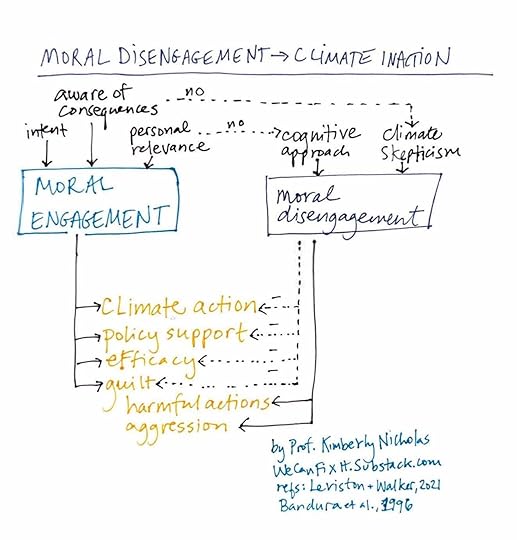 Factors leading to either moral engagement, which increases climate action and a sense of agency (efficacy), or moral disengagement, which decreases climate action. Source: figure created by Kim Nicholas, based on studies by Leviston and Walker and Bandura et al.
Factors leading to either moral engagement, which increases climate action and a sense of agency (efficacy), or moral disengagement, which decreases climate action. Source: figure created by Kim Nicholas, based on studies by Leviston and Walker and Bandura et al.On the other hand, moral disengagement decreases all the good stuff: climate action, a sense of efficacy. But it decreases guilt, which the theory’s founder hypothesized was one of its main purposes. (The original 1996 study found moral disengagement increases harmful actions and aggression. Like the world needs more of that…!)
Now, how do people wiggle out of a moral framing?
8 mechanisms for moral disengagement, with climate examples1. Justification: “The ends justify the means.” “There was an economic benefit, so the climate harm doesn’t matter.”
2. Advantageous comparison: “Exxon/Elon is worse.” “It’s the lesser of two evils.”
3. Euphemistic labelling: think “green flying,” “carbon neutral.” Basically greenwashing to make things sound less harmful.
4. Minimize, ignore, distort the harm caused: “This is just a drop in the bucket.” “Climate change isn’t such a big problem.”
5. Displace responsibility: Point the finger at others to diminish your own accountability. “Leaders are more responsible than me,” so I don’t have to do anything.
6. Diffuse responsibility: “Change the system; everyone is responsible,” so no one feels responsible. Obscure the consequences of your own actions.
7. Dehumanize: “’Those people’ aren’t like us.” Create distance from others to diminish their value.
8. Blame the victim: “Greta is just in it for the money.” Increase the social stigma of the marginalized or most impacted to justify their suffering.
Sound familiar? Watch out for moral disengagement in conversations and media— it’s supporting climate inaction! We’ll keep building up the personal relevance and moral engagement here— I’ll write more about how to face these arguments in a future post.
Feelings: Climate excludedI heard a really interesting reader perspective I want to share with you:
“I started dedicated climate work and volunteering last year, and - I can only speak for myself here - it was not as easy as many people make it sound.
Making connections was harder than I thought, getting support was harder than I thought. Just getting an email back was harder than I thought.
Now, maybe this is not supposed to be easy. And no one owes anyone any connections or support.
But when a movement or a sector says "We need all of you, just get involved" and then makes the "getting involved" part feel very difficult, I think something is off. Expectations are being set that are not met.”
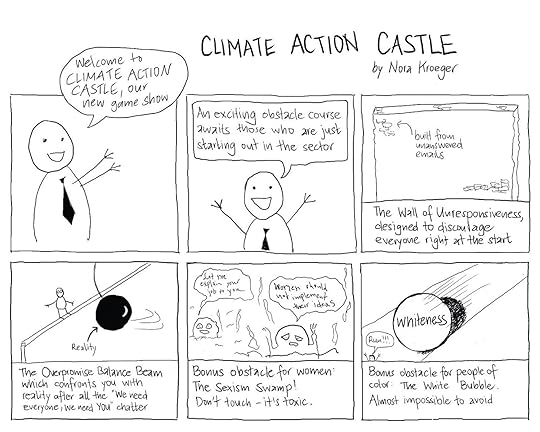 Source: Nora Kroeger on LinkedIn
Source: Nora Kroeger on LinkedInFor ages, climate people have been working hard to expand the circle of “people who potentially care” to “people who care + are doing useful work.” A lot of folks have gotten the message, “Hey we need you! Please join in, show up, roll up your sleeves!” And they’re heeding that call, and trying to jump in, which is SO great!
But it can be tough to get started. How do you find the right group for you? (Refresher: “Find your Climate Peeps” from Sept 2021!) How do you align your skills to contribute once you find them?
It’s super concerning to hear people have not felt welcomed, found it difficult to break in to a climate group, or even not heard back at all after several attempts. This is a lot of lost energy, creativity, and capacity that the climate movement desperately needs.
This experience Nora brought up inspired this month’s climate action, which is…
Action: Make it easy to say YES!Here are two things that are sometimes at odds with each other in climate action:
We need to help each other, ask for help when we need it, draw on each others’ strengths, learn from each other, share the load…
YES, AND we need to support a sustainable working culture, not glorify overwork, respect others’ boundaries and not set unreasonable demands on their time.
SO, how can the new folks who want to learn, contribute, and find their place (yay!!) get the support they need…
WITHOUT burning out the too-few people already neck-deep in the climate work they’re desperately trying to get done? It takes a lot of time and energy to welcome and guide new folks and bring them up to speed. Often that process can be super rewarding and fun. But sometimes, it can be a one-way drain to try to bounce between too many demands that don’t end up going anywhere.
Nora’s post made me think about the requests I get for my time. I do not have capacity to say yes to them all. What makes it easy for me to respond immediately and to say YES? What does not make it easy for me to respond — and therefore maybe ends up unanswered in my Inbox 4,784 that horrifies my Inbox Zero friends?? I’m doing my best, but I definitely drop some balls, which I feel bad about.
With that in mind, here’s this month’s action:
How to get people you don’t already know to answer your emails!Especially when you’re asking them for something. I think this skill could come in super handy in building climate community and new connection— and if done well, save us all a lot of time and stress.
Something I didn't realize until it happened to me: even if you’re reaching out to someone with a lovely offer, like “Can I help you?”, it requires substantial work for the receiver to figure out if you can help, and how.
The easier you make it for someone to know how to answer you right away, and to give you an answer with a response they can write in 2 minutes, the more likely they are to respond.
Here are things that make it easy to say YES!Explain why you’re contacting them in particular. What is it about their work that resonated for you?
This means you should first do a bit of homework! Read their latest book/article/Substack/social media feed, and mention something specific you saw that led you to contact this human being. No one replies to a generic mass email.
Ask yourself, “What does this person want to achieve in the world? How could my ask help them do what is important to them?”
It’s easy to write an email that only contains “I” as a subject: I am so-and-so, I live here, I work here, I want this thing, [long descriptions/explanations of any of the above].
It’s worth thinking about the human being who will receive your request. What's in it for them? How can you make them the subject? [People love being the subject.] How can you align your ask with their goals? Win-win!
It’s fine to ask for a favor! People like helping others when they can. If you’re doing this, in my experience, it works best to state, “I’m writing to ask for your help/ a favor.”
Make a clear, specific ask.
Basically, make sure your message covers the classics: who, what, when, where, why. But I’d suggest this order: why [you’re contacting them in particular], who [you are/how you know them], what [you’re asking for, specifically], when/where [so they can check their calendars right then].
If it’s an event you’re asking them to join, send relevant info like other people on the program, audience background and intended learning outcome, how many are expected, online or in person, etc.
Out of the blue, “I’m interested in climate too! Let’s jump on a call to discuss” is not a clear, specific ask, tech bros from LinkedIn! :)
Keep it short!
The shorter the email, the more likely it is to get a response.
Use line breaks frequently. Make it easy to skim. Imagine they’re reading the email on their phone while waiting in line for the bus. Make it easy for them!
What have you found works for you to connect with new people? What makes it easy for you to say yes? Let me and your fellow readers know in the comments!
See You On the Internet & IRL!Listen: I think this was the deepest dive yet into our study on what works to reduce driving in cities. Thanks, Kea Wilson at Streetsblog!
Come see me in Brussels!
I’ll be at Full Circle next Wednesday, October 3. Come say hi! Get your tickets here.
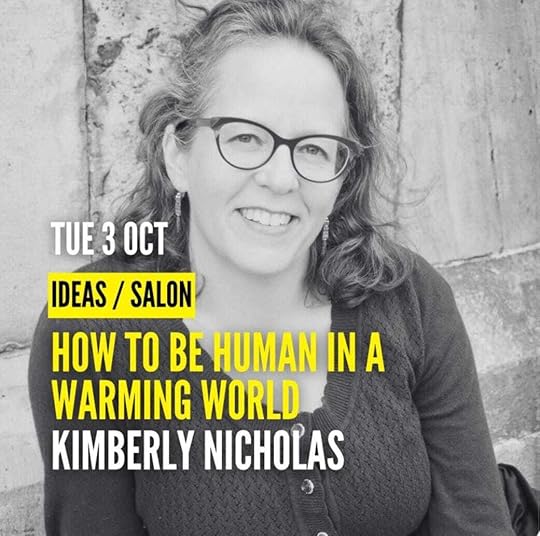 Salon: Full Circle, Brussels, 6:30 PM - 8:30 PM Tue 3 Oct. Tickets.
Salon: Full Circle, Brussels, 6:30 PM - 8:30 PM Tue 3 Oct. Tickets.Book Recommendation: Scattered All Over the Earth, by Yoko Tawada. Just read this for my climate fiction book club and was delighted to suspend my disbelief from page 1. Beautifully observed and written, where climate change colors the characters’ lives but isn’t over-explained. I laughed out loud at some of the descriptions of Scandinavian culture.
xo,
Kim
Thanks for reading! We Can Fix It is a reader-supported publication. To receive new posts and support my work, consider becoming a free or paid subscriber.
August 31, 2023
5 Stages of Climate Feelings
Hi friends,
It’s still summer, dang it! That’s my late-August-in-Sweden vibe. Looking forward to crisp fall days; not so much the dark grey winter ones ahead. But let’s jump straight in. This time we’ll do feelings first, then facts, then action!
5 Stages of Climate FeelingsI’ve developed a 5-stage framework for recognizing and navigating climate emotions. I hope you find it helpful!
 5 Stages of Climate Feelings: Ignorance, Avoidance, Doom, All the Feels, & Purpose. Source: Under the Sky We Make, Chapter 6.
5 Stages of Climate Feelings: Ignorance, Avoidance, Doom, All the Feels, & Purpose. Source: Under the Sky We Make, Chapter 6. Ignorance: We all start here. As we learn about the existence and severity of the climate crisis, our ignorance gets chipped away, and is replaced by…
Avoidance: You know the climate crisis is happening. But you scroll past the headlines announcing the latest record-breaking hurricane, wildfire, suffering. You avoid connecting the dots between the global climate crisis and your own life. Avoidance is a way to cope with feeling overwhelmed, anxious, and uncomfortable. But avoidance itself is actually uncomfortable. It takes a lot of energy to live with the cognitive dissonance of not acting on your knowledge and values. (I was stuck in this stage for years about my own frequent flying.)
Doom. One day, it becomes less uncomfortable to face the cognitive dissonance than continue to avoid it. You might Google yourself down a black hole and feel scared, paralyzed, lonely, or hopeless. This is rock bottom. If you get stuck here, you may wallow in despair, or take self-righteous solace as a climate doomer to absolve yourself of all these uncomfortable feelings. :(
All the Feels: If instead, you find ways to acknowledge and tolerate all the uncomfortable emotions, like grief and anger, that are healthy responses to the climate crisis, you get on a better path. You practice ways to notice as these feelings come and, inevitably, go. You do things that make you feel good and build up your physical and mental health and social connections. You know the list: exercise, time in nature, sleep, healthy eating, mindfulness, therapy, music, journaling, wine and laughter and tears with BFFs... These practices ground you in the present, and keep you resilient for the long haul, surfing the waves of all the climate feels. Building and strengthening community lets you pick others up when they’re down; they do the same when you need them.
Purpose. You harness the strength of your feelings to use the climate crisis as a crucible to create meaning in your life. You pursue goals chosen to serve your core values and take care of what matters most to you. You find ways to combine what you love, are good at, and have fun doing to offer your talents towards what the world needs.
What do you think, does this resonate with your experience?
This section is drawn from Part II of Under the Sky We Make.
Facts: Investments PolluteFor the wealthiest Americans, their most polluting possession is not a second home, bulky SUV, or even a private jet. It’s their investment account.
We’ve long known that investments matter for climate (see: the fossil fuel divestment campaign, or our study identifying investor as one of 5 Climate Superpowers).
With a new study, we now have a more complete picture of how money gets turned into climate pollution.
Studies of household income usually look at wages (the paycheck you bring home). This new study led by Jared Starr also included income from investments (like stocks and funds) and retirement accounts.
Key findings:
For the top 1% of American households (total income starting at $554,000), investments pollute a lot (olive bars in the graph below).
Investments are the largest source of emissions for the top 0.1% (households with incomes of $2.2 million or more; bar furthest to the right).
The 10% poorest households pollute about 2 tons/year. The wealthiest 0.1% emit more than 1,000x that much.
The group that pollutes the most in total is the “next 9%”, 90-99% (the widest bar in the graph below). This group has total household incomes starting at $179,000.
 US household emissions (bar height) per income group (bars). Cumulative share of national emissions = bar width. SOURCE: Figure: Starr et al., 2023, PLOS Climate, Figure 4. Income cutoffs for households: Provided by Jared Starr, with help from Dan Moran. Green/orange/red boxes and text annotations added by me.
US household emissions (bar height) per income group (bars). Cumulative share of national emissions = bar width. SOURCE: Figure: Starr et al., 2023, PLOS Climate, Figure 4. Income cutoffs for households: Provided by Jared Starr, with help from Dan Moran. Green/orange/red boxes and text annotations added by me. This study also reaffirms:
Income is basically equivalent to emissions. There’s a very strong relationship between higher income = higher emissions. Thus, income inequality drives emissions inequality.
The rich pollute a lot, and the poor pollute very little. The poorest 50% of households cause about 10% of climate pollution (green box above). The richest 10% of households cause 4x that much (orange box).
Inequality is large and growing for both income and emissions. :(
The authors suggest a carbon tax on investments in this video and this piece in The Conversation.
Big picture:
“At the moment, the way the economy works is that it takes money and turns it into climate pollution that is destabilizing life on Earth. And that fundamentally has to change.”
-Me to Laura Paddison in a CNN interview about this study
Want to make your investments aligned with climate solutions? Keep reading! :)
Thanks for reading We Can Fix It! Subscribe for free to receive new posts and support my work.
Action: Divest YourselfIf you’re in the fortunate group who owns investments (like pension funds, mutual funds, or company stocks)… they probably have a big carbon footprint.
➡️ Check the climate grade of your portfolio at fossilfreefunds.org.
Here’s an example for a popular mutual fund from Vanguard (valued at $1.3 trillion).
I typed the ticker symbol into the Fossil Free Funds search:
 Check the fossil content of your investments with the Fossil Free Funds tool.
Check the fossil content of your investments with the Fossil Free Funds tool. This behemoth gets a grade of D. The fund has over $100 billion invested in fossil fuel companies like ExxonMobil, Chevron, and ConocoPhillips. Yikes.
 Popular, but 8.23% fossil fuels :(
Popular, but 8.23% fossil fuels :( What do you do if your portfolio looks like this??
In brief:
Divest— Get rid of the dirty stuff (sell or donate it to a nonprofit), then
Reinvest your money in good stuff that supports climate solutions!
There are lots of options out there. Discuss with a financial advisor what makes sense for you.
Handy guides:
Action Toolkit and Resources for Investing from Fossil Free Funds
5 Steps to a Sustainable Retirement Plan from Invest Your Values
In case it’s helpful, one reinvestment option I personally chose is Etho Climate Leadership. It’s a diversified fund of climate leaders in their respective industries. Companies must be at least 50% more decarbonized than their industry peers (nerd out on methodology). All fossil fuel companies are completely excluded.
Parting TidbitsI talked with Nathan Zvi on The Net Zero Life about
some of my favorite climate books (3:00),
how studying climate now is different than when I was a student (“my students are running into a building that’s on fire, and they know that”; 11:00),
and whether development needs can justify fossil fuel use (39:00).
Listen here:
Book RecommendationOnce There Were Wolves, by Charlotte McConaghy. Haunting, fierce, and tender climate fiction about a woman trying to reintroduce wolves and rewild Scotland, over the objections of her new neighbors. A beautiful reflection on the web of life.
xo,
Kim
P.S. Simon and I got a sailboat!! Low-carbon adventures, here we come!
 A calm day on the Öresund from our new sailboat!
A calm day on the Öresund from our new sailboat! Thank you for reading We Can Fix It. If you found this post valuable, please share it with a friend.
May 25, 2023
Circular starts with using less
Hi friends,
It’s been a minute! Since I last wrote, I had a fantastic time as a visiting scholar at Stanford, getting inspired by tons of smart folks at the new School of Sustainability (and bonding with beloved people and landscapes in California, and eating a lot of excellent tacos). I have so many new ideas to share with you that I don’t know where to start. So let’s just dive in!
Thanks for reading We Can Fix It! Subscribe for free to receive new posts.
Facts: Circular starts with using lessThe circular economy is getting lots of buzz. But to actually go from a linear “take-make-waste” world to a lovely infinite loop, one key idea often gets lost:
A circular economy starts with using less.There’s so much focus today on optimizing efficiency: using materials fully, without waste.
Efficiency is good! It saves money! No one likes waste!
But many of us today are consuming resources far faster than the Earth can regenerate them. For example, the average US resident consumes as if there were 5.1 Earths, when of course there’s only this one we all share. Switzerland just passed its “Earth Overshoot Day” on May 13.
Even if we eliminated waste and consumed perfectly efficiently, this total amount of consumption is too high. Womp womp!
That’s why a circular economy starts with using less. We have to right-size the amount of consumption first to get the whole circular system to work.
A recent paper by Jan Konietzko and colleagues highlights four elements of a circular economy:
Narrow: use less materials and energy
from design through use and recovery. This stage includes new business models, like incentivizing consumers to consume less, and encouraging sharing to decrease the total number of products needed.
Slow: use longer
by designing for durability, and using business models that offer a product as a service.
Close: use again
so that products are reused or recycled after a consumer uses them. This includes designing for recycling, producers supporting product and component returns, and developing waste-to-product offerings, like soap made from coffee grounds.
Regenerate nature
by using non-toxic and renewable materials, powered by renewable energy, and recovering nutrients that are usually lost (like turning pee and poop into fertilizer).
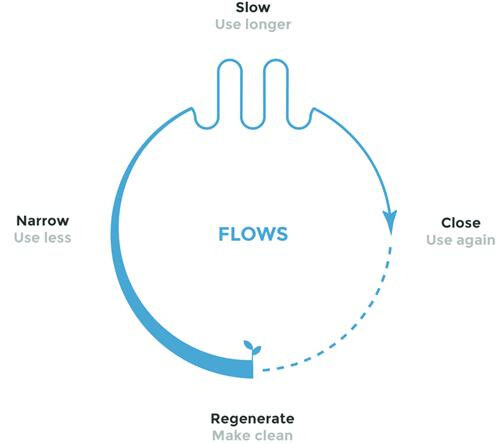 Four elements of a circular economy: Use less, longer, again, and make clean. Source: Konietzko et al., 2020. Thanks to Jessika R for the tip!
Four elements of a circular economy: Use less, longer, again, and make clean. Source: Konietzko et al., 2020. Thanks to Jessika R for the tip! How can you apply these four circular principles in your home or at work?
Feelings: Inspired by Land CareIn California, I spent time in beautiful places being restored and cared for by dedicated people, and it was soul-nourishing.
I visited the monarch butterfly habitat at Ellwood Grove near Santa Barbara. The grove is beautiful, but needs some love. When I visited, the trail was flooded, and there were many downed trees that broke up the shelter the butterflies rely on; only a few trembling monarchs had made it through the latest winter storm. But my tour guide George Thomson, Parks and Open Space Manager for the City of Goleta, has a plan to reduce fire risk and improve butterfly habitat in the grove, and has secured state funding to start making this plan a reality.
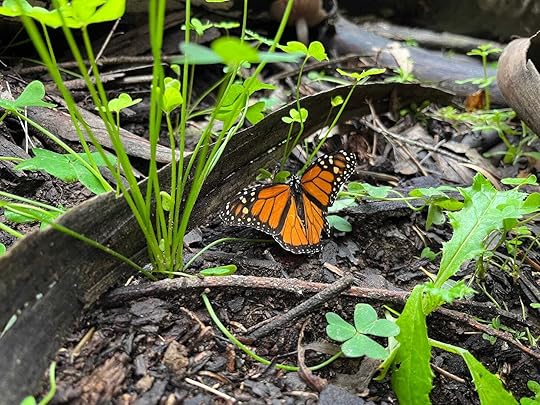 A monarch butterfly that made it through a winter storm in Ellwood Grove, Goleta, California. Photo: Me
A monarch butterfly that made it through a winter storm in Ellwood Grove, Goleta, California. Photo: MeMy college buddy Dave Halsing now has the very cool job of restoring 15,000 acres of tidal wetland in the San Francisco Bay (the largest such project on the West Coast!). I felt like an afternoon exploring the shoreline with Dave gave me “marsh goggles” with which to see the world. The Bay is, of course, a defining feature of the Bay Area, where I grew up, but it’s been so heavily transformed I often barely see it. Standing on a hill at Bedwell Bayfront Park at sunset, with healthy tidal marsh to the north and the former salt ponds Dave is restoring to the south, I felt energized.
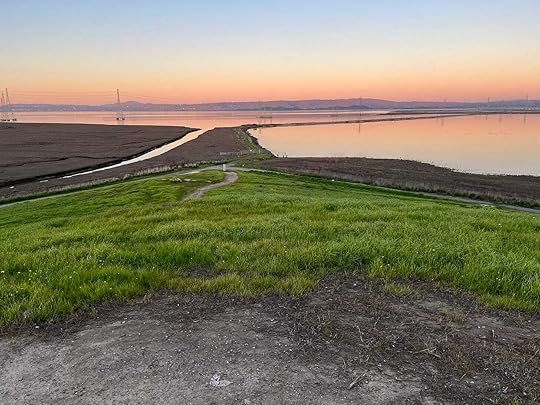
And I joined Edgar McGregor on his daily #EarthCleanUp, picking up trash from a local park. I asked him how over 1,300 days of cleaning up a mess others had left behind had changed his view on human nature. I loved Edgar’s answer:
"I try not to think about the litterbugs. It's demotivating. Instead I think about the cleanup as a treasure hunt. It makes me happy to be out here."
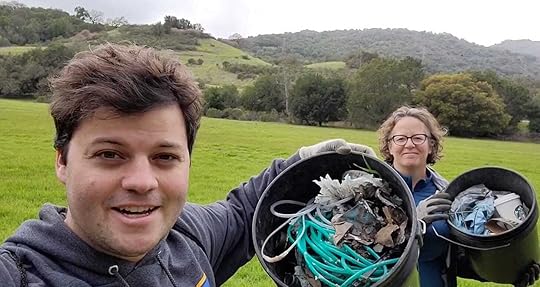 Joining Edgar for #EarthCleanUp. Click for his 2 min video summary. Source: Edgar McGregor
Joining Edgar for #EarthCleanUp. Click for his 2 min video summary. Source: Edgar McGregorIs there a local park near you that could use some love? It just takes a bucket, a pair of gloves, and a bit of time. What about a local land- or sea-scape being restored? The organizers could probably use some volunteers…
Thank you to all of the people doing the work to care for nature— I felt inspired to learn from you!
Action: I got a heat pump!You know about heat pumps, right?? Those magic boxes that both heat and cool your home by moving air around?
Heat pumps are a great example of what it looks like to “electrify everything”— replacing stuff that runs on fossil fuels (in my case, a propane furnace) with stuff that runs on clean electricity. As I wrote last fall, heat pumps are one of the best ways to save energy at home.
On this extended visit back to California, I managed to find a contractor who’s an expert in heat pumps, and get almost all the work done while I was there. Yay! (The final permitting inspection is scheduled soon, which should be the last step— fingers crossed!) Here I am the day the heat pump was turned on. I was joined by a group of Stanford students working on a project to make it easier for homeowners to install heat pumps, who used my house as a case study.
 Five heat pump fans, and a heat pump! Photo: me Your key actions to make way for a heat pump:
Five heat pump fans, and a heat pump! Photo: me Your key actions to make way for a heat pump: Start planning now to replace your current fossil space heating system with a heat pump. Most furnaces are only replaced after they break. If you’re caught desperate to have a livable house in a heatwave or a cold snap, you won’t be in a good spot to get a heat pump sorted.
In the US, the good folks at Rewiring America have great guides for what and how to electrify your home for both owners and renters, including how to save money with federal incentives. Check out their 10 step electrification planning chart!
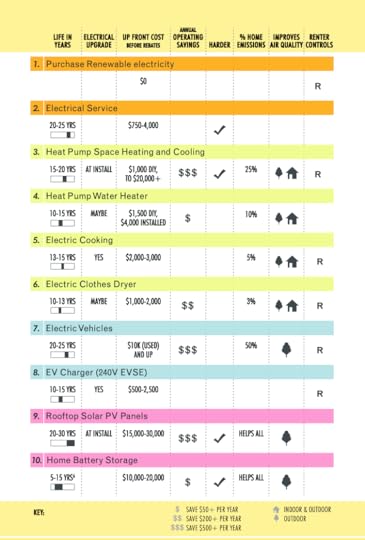 10 things to electrify in your home, from Rewiring America’s guide to help you plan to electrify smart. You don’t have to start in hard mode (heat pumps).
10 things to electrify in your home, from Rewiring America’s guide to help you plan to electrify smart. You don’t have to start in hard mode (heat pumps). Befriend a contractor who has installed lots of heat pumps, so you know who to call when you’re ready. Ask around for personal recommendations. I found Electrify My Home thanks to my friend Rahul. Founder Larry Waters has been in HVAC for 40 years, got heat pump fever in 2015, and started Electrify My Home to exclusively install heat pumps. It was refreshing to work with a contractor who got the big picture. He wasn’t trying to sell me on (artificially) cheaper fossil options. He knew how to size the heat pump based on an energy analysis of the home. He came over and ventured up a ladder to the attic (“not as bad as I expected”) and into the crawl space under the house (“worse than I expected”) to design insulation recommendations that would make the house as efficient as possible to further minimize the energy needed. Good stuff!
If you haven’t already, start saving for your home electrification in your “future box". I wrote about why the future box is better than buying offsets in Under the Sky We Make:
After I’ve reduced my own emissions as much as I can, one option I like for dealing with my remaining emissions is a “future box.” Every time you spend money on fossil fuels (fill up the car, buy a plane ticket), put an equivalent amount of money aside for your future box. This is money to invest in future reductions of your own emissions toward zero (like replacing a propane heater with an electric heat pump)….Given the vast undervaluation of the true cost of carbon today, offsets are usually too cheap. Doubling the cost of gas and flights is much closer to the true social price, meaning you will spend more money toward a worthy cause than you would through an offset, and you’re also more likely to reconsider what is truly necessary carbon spending.
Happy electrifying!
Parting TidbitsI got to chat wine and climate with the wonderful Elaine Chukan Brown on the Jancis Robinson podcast. Have a listen:
Book RecommendationTo Dye For: How Toxic Fashion Is Making Us Sick--and How We Can Fight Back, by Alden Wicker. (Preorder now— publishes June 27!)
I got to read an advance copy! Here’s my review: “Concerning and empowering. Wicker encourages us to listen to women and our own bodies, to choose slow and low-tech fashion for our own health and the planet’s, and to hold toxic fashion manufacturers accountable. I hope we’ll see ingredient lists on clothing and a paradigm shift towards protecting consumer health as a result of this important book.”
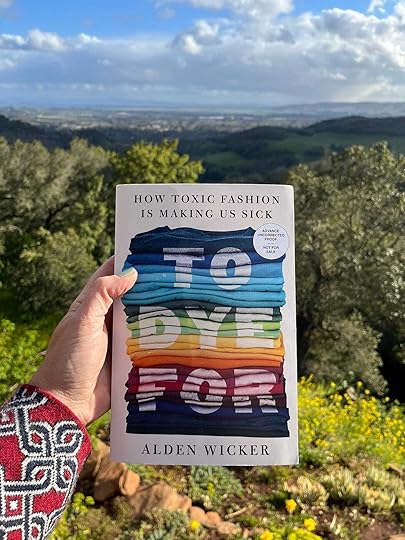
xo,
Kim
Thanks for reading We Can Fix It! Subscribe for free to receive new posts.



